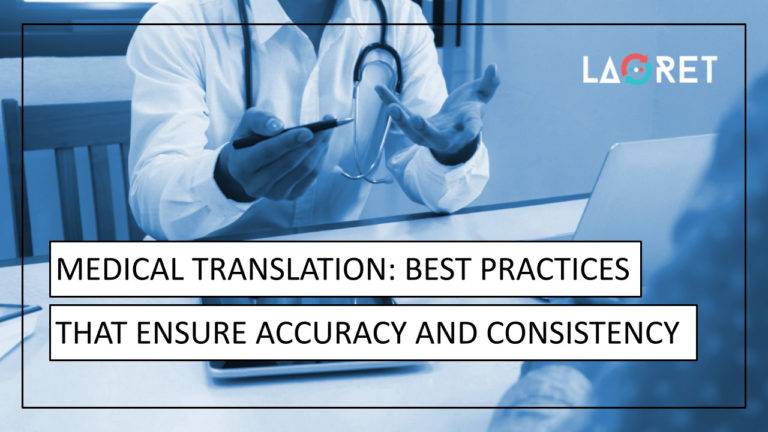Medical Translation: Best Practices That Ensure Accuracy And Consistency
The medical industry is one of the fastest growing industries requesting translation services. But it is also one of the most complex industries to translate for. Accuracy doesn’t only matter from a linguistic and technical perspective, but also from a legal standpoint.
Patient safety, high-quality support for those with limited English proficiency, and medical practice reputation need to be safeguarded at all times. So, what are the best medical translation practices? What’s more, what does this look like from the perspective of clients?
What You Can Do: Make Medical Translation Run More Smoothly
A quality medical translation will, for the most part, depend on an expert LSP. They will need to possess a specific level of experience and expertise to make it work (more on that later!). But you, as a medical institute, can also do your part so that the costs can be kept down, and the translation process can be maximized. Here is how!
- Make sure you prepare for the new strategy to be implemented in your medical institution. Whether you will be looking for translation services or interpreting services, you will need to provide a sustainable plan so you can get the services you need on a rolling basis without disruptions.
- Collaborate with the LSP of your choice to establish a plan that will fit into your practice perfectly. In order to achieve this, together, you will need to determine what type of translation process will work best for you. For example, do you need documents to be translated on a regular basis? Do you need remote interpreting? Do you need both?
- Maximize the translation process by contributing. Understand how the process works and know where your input would ensure the best results. For this, you will need to provide your LSP with a Glossary and a Style Guide. A glossary will list industry-specific terminology and their approved translations to ensure consistent terminology usage, and a style guide will include certain stylistic preferences such as formatting, acronyms, tone, and so on.
- When you need special forms translated, make sure they are already simple in design and language. This will serve your patients as well as the LSP. The LSP will be able to provide results more quickly, and your patients will be able to understand the documents, even if they only possess a minimum education level.

Best Practices You Should Be Looking For In A Medical Translation Vendor
It is easy enough to say you need to look for a professional LSP to handle your medical translations, but what exactly are the medical translation best practices the LSP should secure?
Accuracy And Consistency
Medical Documents should first and foremost be accurate and make use of consistent terminology. Any errors could prove detrimental for the patient’s health as well as the medical institution’s reputation. So how does the LSP secure accuracy and consistency?
The glossary and style guide provided by you will go a long way to achieving this. The LSP will set up the glossary within a specialized Translation (CAT) Tool so that medical terminology management can be optimized. Part of this process includes the use of a Translation Memory (TM). The TM will save previously translated terms and implement them again in any future translations.
Pro Tip! Do you want to know more about how effective Terminology Management helps save time and money? Then check out our blog Terminology Management: The Way To Consistent And Qualitative Translations where we give a detailed overview of what effective terminology management is and how it will benefit translations!
It is important to note that a true quality indicator of an accurate medical translation doesn’t exactly demand a literal translation, but rather equivalence. Equivalence aims to offer a translation that is similar to the original and offers the best chance for complete comprehension.
Such a level of quality can only be achieved by working with subject-matter experts exclusively. The medical industry is highly specialized and consists of various translation types. This means that whichever linguist will be set the task of translating the content should possess the following qualification:
- A medical background in the specific field they are translating for such as cardiothoracic, orthopedics, oncology, pharmaceuticals, pathology, neurology, urology, and so on.
- Years of experience translating in the medical industry.
- A native speaker who resides in the country and region the content is intended for.
- Specialized knowledge of different content types, whether it is for software localization, website localization, interpreting or even mobile app localization.
- A solid grasp of the laws and regulations in the region/ country they are translating for, so all legal formalities are intact.
Laws And Regulations In The Medical Industry
When it comes to regulations in medical translations, there are regulatory standards that medical translations should adhere to. And any LSP worth their salt will apply these rigorously. Authorities such as the EU, EMA, FDA, MDR, and EDQM have a set of clearly defined restrictions and regulations on a local, national, and international level. In order to protect the safety of the patient and the quality of the materials and content, these regulations include:
- Accuracy of translation and terminology used, as well as proper design and formatting
- Data security
- A streamlined management system
- Specific languages that require a mandatory translation
Remember that regulations are subject to change. For example, the updated EU Medical Device Regulation (EU MDR) is mandatory for all LSPs as of 2020.1 The number of languages per applied device and medical labels require more tight legal regulations as well. The same goes for other types of medical content such as medical mobile apps, where regulatory bodies will have a strict set of rules covering application types, legal regulation for the labels, and languages.
A Streamlined Localization Process And Quality Assurance
During the translation process, professional translators commit to a rigorous Translation, Editing, and Proofreading (TEP) Process. A translation strategy that suits the medical field very well, is back translation.
The back-translation process is set in place to weed out possible inaccuracies in terminology, cultural ambiguities, and of course grammatical errors, making it ideal to translate highly technical or sensitive information where there is absolutely no room for ambiguity. With back translation, an independent translation team with no exposure to the source documents will retranslate the content from the target language back into the source language. The original translation and the back translation are then compared based on a detailed report, so the content and quality can be verified.
While the TEP Process and back translation are designed to insert Quality Control on every level of the translation, a Quality Assurance process is still provided at the end where the translation is further confirmed and any possible inaccuracies are weeded out.
With these strict quality procedures, you might be concerned about your medical translation project cost. However, a professional LSP leverages the power of cutting-edge technology to provide cost-efficient solutions and flexible pricing plans.
Confidentiality And Security
Medical content can contain patient information or in the case of specialized research and studies even unpublished facts, so you have to make sure that the LSP you are engaging with will handle all sensitive documents with the utmost confidentiality and privacy through end-to-end encryption. This feature should be further enhanced by using a tightly constructed confidentiality and non-disclosure agreement for everyone involved in the project.
Technical Authority
We have already mentioned CAT Tools and that technical authority can help greatly in producing consistent and accurate content and, due to its efficiency, boost turnaround time and cost-efficiency. This is one of the reasons why you should keep an eye out for an LSP’s technical authority.
Another reason is tied to the fact that, due to the pandemic, a lot of services have gone online. A service crucial to the medical industry is interpreting. Virtual interpreting services are all about innovation and adaptability. And even though Virtual Interpretation has been around for decades, current circumstances have seen it develop fully and refine its services to suit various needs.
This is why a quality LSP will have the tools and platforms to provide these services such as Video Remote Interpreting (VRI) and Remote Simultaneous Interpreting (RSI). Quality video and audio technologies and a high-speed Internet connection have to be provided to connect clients and professionals around the world. This will enable hospitals, physicians, mental health care facilities, and more to provide 24h services to patients from various linguistic and cultural backgrounds.
Pro Tip! Want to learn more about the application of Virtual Interpreting in the medical industry? Check out our blog on Why The Healthcare Sector Needs Access To Medical Interpretation Services!
Conclusion
Certified Medical Translation Services are in high demand. It has made the streamlining of a qualitative process all the more crucial. In order to secure the health of patients and the reputation of your medical facility, translations must adhere to a high level of accuracy and consistency. This is why it is paramount that the clients do their part to contribute with glossaries and style guides. In turn, LSPs should provide native, in-country experts and an optimized translation process.
At Laoret, we rely on linguists with native language authority and years of medical background. Our CAT Tools are tailored to your specific needs and are set up to maximize your unique terminology base and glossaries. Reach out to us anytime, from anywhere, and benefit from fully online translation services safeguarded within an end-to-end encryption communication.






